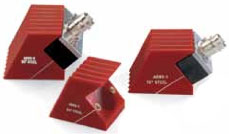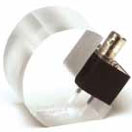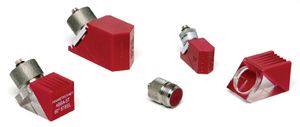6.2 Angle Beam Probe Selection
 The various types of ultrasonic transducers used in flaw detection applications were discussed in Section 4.1. In construction weld inspection, angle beam probes are the primary tool, supplemented by straight beam transducers. Angle beam probes may be
comprised of separate, interchangeable transducers and wedges, or they may be integral assemblies. In many cases, the transducer/wedge combination to be used for an inspection will be specified by a relevant code or inspection procedure. If no probe has been specified, the inspector must select one appropriate for the test at hand based on the following considerations.
The various types of ultrasonic transducers used in flaw detection applications were discussed in Section 4.1. In construction weld inspection, angle beam probes are the primary tool, supplemented by straight beam transducers. Angle beam probes may be
comprised of separate, interchangeable transducers and wedges, or they may be integral assemblies. In many cases, the transducer/wedge combination to be used for an inspection will be specified by a relevant code or inspection procedure. If no probe has been specified, the inspector must select one appropriate for the test at hand based on the following considerations.

Frequency:
Angle beam transducers are generally available in frequencies from 500 KHz to 10 MHz, however most weld testing is performed at frequencies between 2 MHz and 5 MHz. Lower frequencies provide greater penetration across long sound paths or through coarse grained metal, while higher frequencies provide better resolution of small flaws. If not otherwise specified by code, 4 MHz or 5 MHz is usually a good frequency with which to begin an evaluation.

Angle:
Almost all angle beam testing is performed at standard angles of 45, 60, and 70 degrees, although 30 degree and 90 degree (surface wave) wedges are also used in some specialized cases. As a general rule, higher angle wedges (60 and 70 degree) are commonly used when metal thickness is less than approximately 25 mm (1”), and lower angle wedges (45 degree) are commonly used when metal thickness is greater than approximately 50 mm (2”). Two or three different angles may be used in a given test based on part geometry and flaw resolution requirements. Further information can be found in common inspection codes. The wedge angle in a given case should be high enough that a first leg signal can reach the weld root from a position on the part surface that is not obstructed by the weld crown.
Size:
Angle beam transducers and wedges are available in a wide range of shapes and sizes, with round, square, or rectangular elements. North American industry practice favors the use of round elements (except in AWS code inspections), while European practice favors square or rectangular. The most common element sizes include 0.25”, 0.5”, and 1” diameter for round elements and 8x9 mm, 14x14 mm, and 20x22 mm for square/rectangular elements, however a number of other standard sizes are also available. Smaller elements can provide better resolution of small flaws, and smaller wedges can more easily conform to curved surfaces. Larger elements provide more area coverage and thus faster scanning, as well as reduced beam spreading across long sound paths.
 With these considerations in mind, the inspector should use his/her knowledge and experience to select the optimum probe or probes for a test. Where possible, probe performance should be verified on test standards containing appropriate reference reflectors or known defects.
With these considerations in mind, the inspector should use his/her knowledge and experience to select the optimum probe or probes for a test. Where possible, probe performance should be verified on test standards containing appropriate reference reflectors or known defects.
